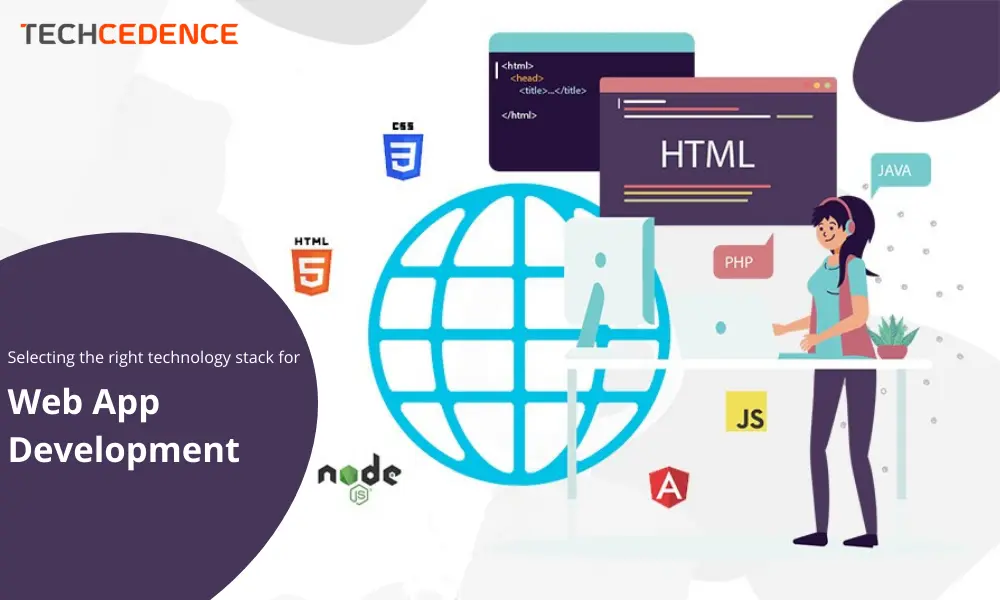
Categories : Web App Development
Author : Date : Aug 31, 2021
Choosing the technology stack is the first step for successful web application development. Organizations should spend time and effort in selecting the right technology stack for building a web application.
A technology stack is a combination of tools, programming languages and frameworks used by developers to build an application. In short, it is a collection of software used for web development.
Web application development involves front end development and back-end development. The front end is where the user interacts with the application and back-end refers to the server-side of the application that communicates user requests to the server.
Front end development involves three primary coding languages that can be used to build a basic web application.
In addition to these, there are some open-source Javascript frameworks that are taking over the front end development which includes React JS, Angular JS, Vue JS, and jQuery.
React JS is the most trending technology for front end development. React JS is a flexible Javascript library as it enables faster UI development using reusable components. It can be integrated with external libraries like jQuery.
Angular JS is the preferred framework for creating interactive and dynamic web applications. It supports MVC programming structure and two-way data binding which makes it unique.
Vue.js is a progressive Javascript framework for building web interfaces and one-page applications. It is easily adaptable and helps to build robust and reliable applications.
jQuery is a feature-rich Javascript library. It has a collection of plugins and makes front end development easier with ready to use elements like a countdown timer, auto-complete functions.
The challenge lies in selecting the technologies for back-end development. Though it is not visible to the user, it defines the logic and allows the user to perform actions and interact with the application. The back-end is developed using server-side programming languages.
Back end technologies consist of an operating system, web server, framework, server-side programming language, and the database. Some of the popular programming languages for back-end development include Ruby, Python, PHP, Javascript, and .NET. Databases include MongoDB and MySQL. Some of the frameworks include Ruby on Rails, Flask, Django, Swift or Objective-C. The most popular web servers include Apache, Nginx, etc.
Middleware acts as a communication interface between the front end and back-end. It performs tasks such as parsing and authentication.
Users without a strong technical background will find it difficult in choosing the technology stack for their application. Here are some factors that will help users to select the right stack.
Project complexity – The first step in choosing the technology stack is to analyze the size and complexity of the application to be developed. Applications can be small, mid-range or complex projects. Understanding the requirement makes it easy to choose the right technology stack.
Scalability – The selected technology stack should support application growth in the future. The application can grow in terms of the number of users or add more processes and functionality. Developers should select a flexible technology stack that supports the growth of the application.
Maintainability – The application should be easily maintainable. If the code is lengthy, it becomes complicated to process the code. So, select technologies that are easily maintainable and can be updated easily.
Cost – Some of the tools and frameworks are free and open-source while some require a license cost. Depending on the features and usability of the software, opt for technologies that will reduce the software development cost.
Team’s expertise – Team’s expertise on the tools and technologies has to be considered while deciding on the technology stack. The team must be experienced in the technologies to develop a quality application within the deadline.
Project-based – Don’t choose a technology stack used for previous projects. Each project requirement is unique and technology components that proved successful for one project may not be relevant for another.
Ability to process data – If the project deals with loads of data, the application should be designed to handle the load. Select a programming language that can balance heavy loads of data.
Development time – The selected technology stack should facilitate faster development and reduce development time. The faster an application is developed the cheaper the development cost.
Security – Cyberattack is the biggest threat to online applications. Make sure that the technology stack you are considering is not vulnerable to security threats.
Some of the commonly used tech stacks are .NET stack, LAMP (Linux, Apache, MySQL, PHP), MEAN (MongoDB, Express js, Angular js and Node js) and Ruby on Rails.
Choosing the right technology stack is important for any business and offers numerous benefits:
Selecting a technology stack can be a challenge. A wrong choice of a technology stack may result in project failure.
Discuss with our experts who can help you decide on the right technology stack for your product based on your business requirements and budget.